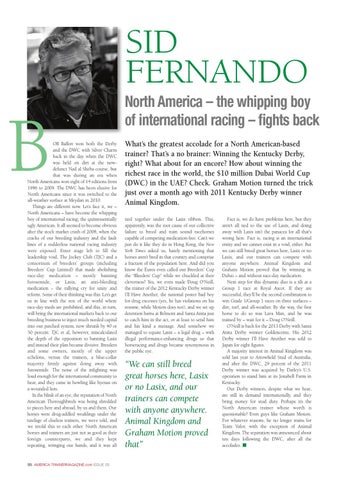FERNANDO NA ISSUE 28_Jerkins feature.qxd 16/04/2013 21:58 Page 1
SID FERNANDO
B
OB Baffert won both the Derby and the DWC with Silver Charm back in the day when the DWC was held on dirt at the nowdefunct Nad al Sheba course, but that was during an era when North Americans won eight of 14 editions from 1996 to 2009. The DWC has been elusive for North Americans since it was switched to the all-weather surface at Meydan in 2010. Things are different now. Let’s face it, we – North Americans – have become the whipping boy of international racing; the quintessentially ugly American. It all seemed to become obvious after the stock market crash of 2008, when the cracks of our breeding industry and the fault lines of a rudderless national racing industry were exposed. Enter stage left to fill the leadership void, The Jockey Club (TJC) and a consortium of breeders’ groups (including Breeders’ Cup Limited) that made abolishing race-day medication – mostly banning furosemide, or Lasix, an anti-bleeding medication – the rallying cry for unity and reform. Some of their thinking was this: Let’s get us in line with the rest of the world where race-day meds are prohibited, and this, in turn, will bring the international markets back to our breeding business to inject much needed capital into our parched system, now shrunk by 40 or 50 percent. TJC et al, however, miscalculated the depth of the opposition to banning Lasix and instead their plan became divisive. Breeders and some owners, mostly of the upper echelons, versus the trainers, a blue-collar majority firmly against doing away with furosemide. The noise of the infighting was loud enough for the international community to hear, and they came in howling like hyenas on a wounded lion. In the blink of an eye, the reputation of North American Thoroughbreds was being shredded to pieces here and abroad, by us and them. Our horses were drug-addled weaklings under the tutelage of clueless trainers, we wer e told, and we retold this to each other. North American horses and trainers are just not as good as their foreign counterparts, we and they kept repeating, wringing our hands, and it was all
88 AMERICA.TRAINERMAGAZINE.com ISSUE 28
North America – the whipping boy of international racing – fights back What’s the greatest accolade for a North American-based trainer? That’s a no brainer: Winning the Kentucky Derby, right? What about for an encore? How about winning the richest race in the world, the $10 million Dubai World Cup (DWC) in the UAE? Check. Graham Motion turned the trick just over a month ago with 2011 Kentucky Derby winner Animal Kingdom. tied together under the Lasix ribbon. This, apparently, was the root cause of our collective failure to breed and train sound racehorses capable of competing medication-free. Can’t we just do it like they do in Hong Kong, the New York Times asked us, barely mentioning that horses aren’t bred in that country and comprise a fraction of the population here. And did you know the Euros even called our Breeders’ Cup the “Bleeders’ Cup” while we chuckled at their cleverness? Yes, we even made Doug O’Neill, the trainer of the 2012 Kentucky Derby winner I’ll Have Another, the national poster bad boy for drug excesses (yes, he has violations on his resume, while Motion does not), and we set up detention barns at Belmont and Santa Anita just to catch him in the act, or at least to send him and his kind a message. And somehow we managed to equate Lasix – a legal drug – with illegal performance-enhancing drugs so that horseracing and drugs became synonymous in the public eye.
“We can still breed great horses here, Lasix or no Lasix, and our trainers can compete with anyone anywhere. Animal Kingdom and Graham Motion proved that”
Fact is, we do have problems here, but they aren't all tied to the use of Lasix, and doing away with Lasix isn’t the panacea for all that's wrong here. Fact is, racing is an international entity and we cannot exist in a void, either. But we can still breed great horses here, Lasix or no Lasix, and our trainers can compete with anyone anywhere. Animal Kingdom and Graham Motion proved that by winning in Dubai – and without race-day medication. Next step for this dynamic duo is a tilt at a Group 1 race at Royal Ascot. If they are successful, they’ll be the second combination to win Grade 1/Group 1 races on three surfaces – dirt, turf, and all-weather. By the way, the first horse to do so was Lava Man, and he was trained by – wait for it – Doug O’Neill. O’Neill is back for the 2013 Derby with Santa Anita Derby winner Goldencents. His 2012 Derby winner I’ll Have Another was sold to Japan for eight figures. A majority interest in Animal Kingdom was sold last year to Arrowfield Stud of Australia, and after the DWC, 29 percent of the 2011 Derby winner was acquired by Darley’s U.S. operation to stand him at its Jonabell Farm in Kentucky. Our Derby winners, despite what we hear, are still in demand internationally, and they bring money for stud duty. Perhaps it’s the North American trainer whose worth is questionable? Even guys like Graham Motion. For whatever reasons, he no longer trains for Team Valor, with the exception of Animal Kingdom. The separation was announced about ten days following the DWC, after all the accolades. n
